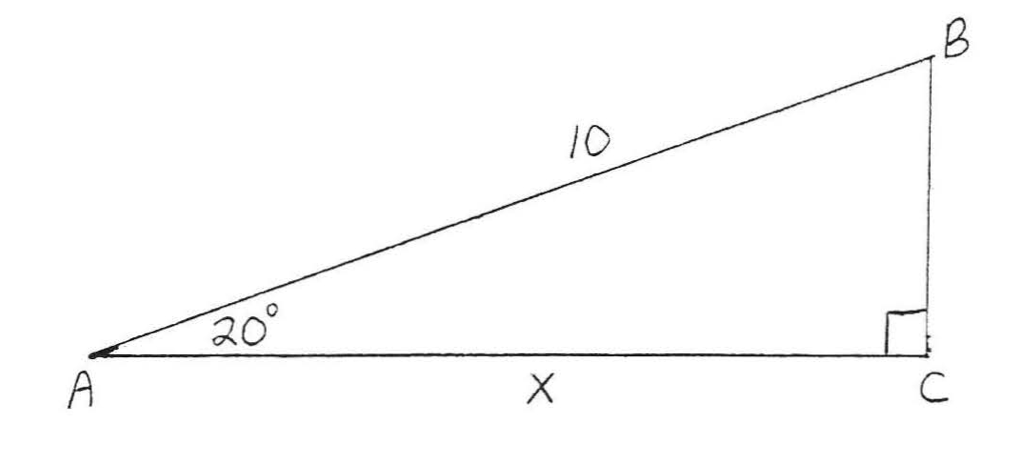Hi Everyone!
On this page you will find some material about Lesson 26. Read through the material below, watch the videos, and follow up with your instructor if you have questions.
Lesson 26: Solving Right Triangles & Applications of Static Trigonometry
Table of Contents
Resources
In this section you will find some important information about the specific resources related to this lesson:
- the learning outcomes,
- the section in the textbook,
- the WeBWorK homework sets,
- a link to the pdf of the lesson notes,
- a link to a video lesson.
Learning Outcomes. (from Coburn and Herdlick’s Trigonometry book)
- Solve a right triangle given one angle and one side.
- Solve a right triangle given two sides.
- Solve applications involving angles of elevation and depression.
- Solve applications involving angles of rotation.
- Solve general applications of right triangles.
Topic. This lesson covers
Section 2.2: Solving Right Triangles, and
Section 2.3: Applications of Static Trigonometry.
WeBWorK. There are two WeBWorK assignments on today’s material:
SolvingRightTriangles
SolvingRightTriangles-InverseTrig
Lesson Notes.
Video Lesson.
Video Lesson 26 – part 1 (based on Lesson 26 Notes – part 1)
Video Lesson 26 – part 2 (based on Lesson 26 Notes – part 2)
Warmup Questions
These are questions on fundamental concepts that you need to know before you can embark on this lesson. Don’t skip them! Take your time to do them, and check your answer by clicking on the “Show Answer” tab.
Review
If you are not comfortable with the Warmup Questions, don’t give up! Click on the indicated lesson for a quick catchup. A brief review will help you boost your confidence to start the new lesson, and that’s perfectly fine.
Need a review? Check Lesson ??
Quick Intro
This is like a mini-lesson with an overview of the main objects of study. It will often contain a list of key words, definitions and properties – all that is new in this lesson. We will use this opportunity to make connections with other concepts. It can be also used as a review of the lesson.
A Quick Intro to Solving Right Triangles & Applications of Static Trigonometry
Key Words. Right angle, hypotenuse, leg, opposite leg, adjacent leg, Pythagorean Theorem, sine, cosine, tangent, cosecant, secant, cotangent, arcsine, arccosine, arctangent, solving a right triangle, special triangle, 30-60-90, 45-45-90, angle of depression and angle of elevation.
Video Lesson
Many times the mini-lesson will not be enough for you to start working on the problems. You need to see someone explaining the material to you. In the video you will find a variety of examples, solved step-by-step – starting from a simple one to a more complex one. Feel free to play them as many times as you need. Pause, rewind, replay, stop… follow your pace!
Video Lesson
A description of the video
In this video you will see the following problem:
A helicopter is flying 1,000 ft over a building. The pilot spots a person with an angle of depression
Try Questions
Now that you have read the material and watched the video, it is your turn to put in practice what you have learned. We encourage you to try the Try Questions on your own. When you are done, click on the “Show answer” tab to see if you got the correct answer.
WeBWorK
You should now be ready to start working on the WeBWorK problems. Doing the homework is an essential part of learning. It will help you practice the lesson and reinforce your knowledge.
WeBWork
It is time to do the homework on WeBWork:
SolvingRightTriangles
SolvingRightTriangles-InverseTrig
When you are done, come back to this page for the Exit Questions.
Exit Questions
After doing the WeBWorK problems, come back to this page. The Exit Questions include vocabulary checking and conceptual questions. Knowing the vocabulary accurately is important for us to communicate. You will also find one last problem. All these questions will give you an idea as to whether or not you have mastered the material. Remember: the “Show Answer” tab is there for you to check your work!
Need more help?
Don’t wait too long to do the following.
- Watch the additional video resources.
- Talk to your instructor.
- Form a study group.
- Visit a tutor. For more information, check the tutoring page.



